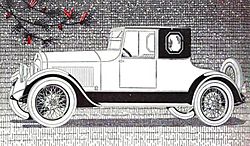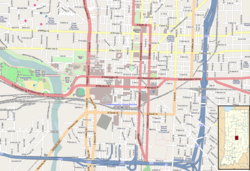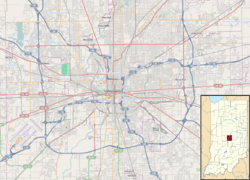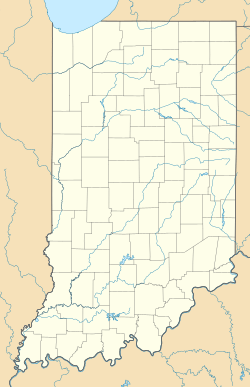Cole Motor Car Company facts for kids
 |
|
| Automobile Company | |
| Industry | Manufacturing |
| Founded | 1909 |
| Founder | Joseph J. Cole |
| Defunct | 1925 |
| Headquarters | Indianapolis, Indiana, US |
|
Key people
|
Joseph J. Cole (Executive Chairman & President) Charles S. Crawford (Chief Engineer) |
| Products | Automobiles |
The Cole Motor Car Company was an early car maker in Indianapolis, Indiana. They built cars from 1908 to 1925. Cole cars were known for being fancy and well-made. This company was one of the first to use the V-8 engine in their cars.
Contents
How Cole Motor Cars Started
Joseph J. Cole first tried to build a car in 1903. He owned a shop with his son that sold car parts and fixed machines. They worked on a 4-cylinder car called the Rockford. But this project didn't work out. Instead, they opened a car dealership.
In 1904, Cole bought a company that made carriages. He renamed it the Cole Carriage Company. Here, he built his first car. It was a high-wheeled motor buggy with a two-cylinder engine. People say he forgot to put brakes on it!
The Cole Carriage Company made about 3,000 carriages each year. They started making cars with engineer Charles S. Crawford. This new car was called the "Cole Solid Tire Automobile." Cole sold about 170 of these high-wheeled cars. But he soon decided they were not the future of cars.
In 1909, the company became the Cole Motor Car Company. They started making a more normal car, the Cole Model 30. It had a two-cylinder engine with 14 horsepower. The car was 90-inch (2,300 mm) long between the wheels. It was a runabout and could have 2, 2/4, or 4 seats. About 100 of these cars were built.
Four-Cylinder Power
A new car came out at the end of 1909 for the 1910 model year. It was called the Series 30. This car had a new 30 horsepower, four-cylinder engine. It was longer, with a 108 inches (2,700 mm) wheelbase. There were four open car styles. The cheapest was $1,400. Cole sold 783 cars that year.
The "Flyer" model was very good in car races. One "Flyer" won a 24-hour race in 1909. Two Series 30 Flyers also entered the 1910 Vanderbilt Cup Races. William "Wild Bill" Endicott won a big 10-lap race. He drove 126.4 miles (203.4 km) in just over two hours.
For 1911, the Cole Series 30 got a longer frame, 118 inches (3,000 mm) between the wheels. New body styles were available, including a roadster and a touring car. There was also a new "Fore-door Touring" car, which had doors for both front and back seats.
In 1912, the Series 30 was replaced by the Series 40. This car was bigger, with a 122-inch (3,100 mm) wheelbase. It had a stronger 40 horsepower four-cylinder engine. Prices for open cars started at $1,885. They also offered fancy "Colonial Coupe" and limousine models. These higher prices put Cole cars into the luxury car market.
The New Six-Cylinder Cars
For 1913, Cole offered three different car lines. There was the Series 40, a Series 50, and their first six-cylinder car. The six-cylinder car was called the Series 60. It had 40 horsepower and a very long wheelbase of 132 in (3,353 mm). Prices for these big cars were high, up to $4,250 for a fancy limousine. For the first time, Cole cars had electric ignition and lights.
In 1914, the Series 40 and 50 were replaced by a new Model Four. This was a 4-cylinder car with 28.9 horsepower. The 6-cylinder car was renamed the Six. It had 43.8 horsepower and an even bigger frame, 136 inches (3,500 mm) between the wheels.
Sales were low in 1914, so Cole lowered prices for 1915. The Four was now called the Standard 4-40 and was much cheaper. The Six was split into two models: the smaller Model 6-50 and the powerful Big Six 6-60. Joseph Cole almost sold his company to William C. Durant, who owned General Motors. But Cole decided not to sell.
How Cole Cars Were Built
Cole could change its car models and engines easily for two main reasons. First, they didn't always change models every year. They updated cars when they felt it was needed.
Second, Cole cars were "assembled cars." This means that important parts like the engine, clutch, and axles were bought from other companies. Some car makers built all their own parts. But Joseph Cole believed that specialized suppliers could make better parts. So, he called his cars "standardized cars" instead of "assembled cars."
The Famous Cole V-8 Engine
Big news came in mid-1915! Just one year after Cadillac introduced the V-8 engine, Cole brought out its own V-8 powered car. Cole would use V-8 engines until the company closed. This engine had 39.2 horsepower. It was built by Northway, a company that also made V-8 engines for Cadillac.
The new Cole car was called the Model 8-50. It had a 127-inch (3,200 mm) wheelbase. There were five body styles, with prices from $1,785 to $3,250. Cole was competing with other luxury car brands like Cadillac.
For 1917, the car was called the Model 860. There were five body styles at similar prices. Some had fun names like "Tuxedo Roadster" and "Toursedan." Cole made 4,193 cars that year.
Smart Marketing
Cole's marketing became very creative in 1918. Slogans included "There's a Touch of Tomorrow In All Cole Does Today." Another was "Did You Ever Go Ballooning in a Cole?" This referred to new "balloon tires" that year. These tires became standard by 1925. The car was advertised as the "Aero-Eight." It had three body styles: a roadster, a "Sportster," and a touring car. They cost $2,395 each. The cars also started to look more stylish.
The 870 Aero-Eight was similar in 1919. But now there were seven body styles to choose from. Prices ranged from $2,595 to $3,795. Some closed cars had a cool octagonal window in the back. That year, 6,225 Cole cars were built.
The "Aero-Eight" Model 880 for 1920 was announced as "The Forecast of Future Fashions." Ads claimed the tires could last for 15,000 miles (24,000 km). Only three open car styles were available. But the names got even more creative, like "Sportosine" and "Tourosine" for some closed cars. These cars had special adjustable windshields. Cole also started using new carburetors and an improved rear axle. The Cole V-8 engine now had 80 bhp (60 kW) and kept this power until production stopped.
In 1921, Cole cars changed only a little. Most of the fancy names disappeared, but "Sportosine" and "Tourosine" stayed. There were 8 body styles, and they were much more expensive.
The End of the Road
Cole opened new, bigger factories in 1922. However, car sales dropped quickly. This was mainly because of a short but serious economic downturn. Even though Cole offered more models and lowered prices, only 1,722 cars were built that year. The car was called the Model Aero Eight 890.
In 1923, the Series 890 Cole cars got stylish drum-shaped headlights and new windshields. They also offered wire wheels instead of the older "artillery wheels." Fancy disc wheels were an option. For this year, some cars had sporty running boards that didn't go all the way along the side. Still, sales were low, with only 1,522 cars made.
Because of falling sales, Joseph J. Cole decided to close his company. He didn't want to risk losing all his money. So, the Model 890, also called the "Master" series, didn't change much for its final years. Prices were cut even more, as low as $2,175 for open cars. A Cole car was chosen to lead the famous Indy 500 race that year.
Before the company finally closed, five car models were available for 1925. Balloon tires were now standard. Joseph Cole began closing his company early in 1925. He sadly died suddenly on August 8, 1925, just before the company was fully closed.
Cole Car Models (1908–1925)
| Year | Model | Engine Type / Cyl. | Power bhp (kW) | Wheelbase in |
|---|---|---|---|---|
| 1909 | Model 30 | Straight 2 cyl. | 14 bhp (10 kW) | 90 |
| 1910 | Series 30 | Straight 4 cyl. | 30 bhp (22 kW) | 108 |
| 1911 | Series 30 | Straight 4 cyl. | 30 bhp (22 kW) | 118 |
| 1912 | Forty | Straight 4 cyl. | 40 bhp (30 kW) | 122 |
| 1913 | Forty | Straight 4 cyl. | 40 bhp (30 kW) | 116 |
| 1913 | Fifty | Straight 4 cyl. | 50 bhp (37 kW) | 122 |
| 1913 | Sixty | Straight 6 cyl. | 40 bhp (30 kW) | 132 |
| 1914 | Four | Straight 4 cyl. | 28.9 bhp (21.6 kW) | 120 |
| 1914 | Six | Straight 6 cyl. | 43.8 bhp (32.7 kW) | 136 |
| 1915 | Standard 4-40 | Straight 4 cyl. | 40 bhp (30 kW) | 120 |
| 1915 | Model 6-50 | Straight 6 cyl. | 29 bhp (22 kW) | 126 |
| 1915 | Big Six 6-60 | Straight 6 cyl. | 39.2 bhp (29.2 kW) | 127 |
| 1916 | Model 8-50 | V-8 cyl. | 39.2 bhp (29.2 kW) | 127 |
| 1917 | Series 860 | V-8 cyl. | 39.2 bhp (29.2 kW) | 127 |
| 1918–1919 | Series 870 | V-8 cyl. | 39.2 bhp (29.2 kW) | 127 |
| 1920–1921 | Aero Eight 880 | V-8 cyl. | 80 bhp (60 kW) | 127 |
| 1922 | Aero Eight 890 | V-8 cyl. | 80 bhp (60 kW) | 1271⁄4 |
| 1923–1925 | Series 890 | V-8 cyl. | 80 bhp (60 kW) | 1271⁄4 |
Learning About Cole Cars
In 1954, Howard Russell Delancy wrote a college paper about the Cole Motor Car Company. This paper became a book. It tells the full story of Joseph J. Cole and his company. Delancy was able to talk to Cole's family and former workers. He also saw the company's old records. Sadly, these records were later destroyed in a flood. So, this book is very important for learning about Cole's history.
The Cole Motor Car Registry
The Cole Motor Car Registry was started again in 2018. Kevin Fleck, who founded the registry, worked with Leroy Cole (who used to run a Cole car club). They gathered a lot of history and information. In October 2018, a website was launched for the registry. It shares information about the company and its cars. It also keeps track of all the known Cole cars that still exist.
The registry has found 75 Cole cars that were known before. They also found two more cars that nobody knew about! This means there are now 77 known surviving Cole cars. The company made 40,717 cars in total. The registry also checks and shares accurate history about the Cole Motor Car Company.
Historic Cole Building
|
Cole Motor Car Company
|
|
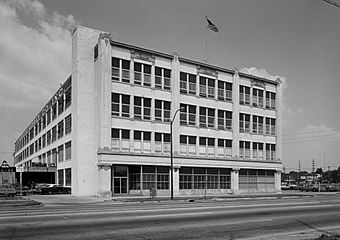 |
|
| Location | 730 E. Washington St., Indianapolis, Indiana |
|---|---|
| Area | 1.5 acres (0.61 ha) |
| Built | 1911–1913 |
| Built by | Bedford Stone & Construction |
| Architect | Halstead, W. C. |
| Architectural style | Late 19th And Early 20th Century American Movements, Modern Movement |
| NRHP reference No. | 83000128 |
| Added to NRHP | March 3, 1983 |
The old Cole Motor Car Company Building is located at 730–738 East Washington Street in Indianapolis. It was built between 1911 and 1913. It's a four-story, "L"-shaped building. The front of the building is made of white ceramic brick. It has cool Art Deco style designs. This building was added to the National Register of Historic Places in 1983.
Images for kids
-
Men in a Cole 30 car at the University of Oregon, around 1910


